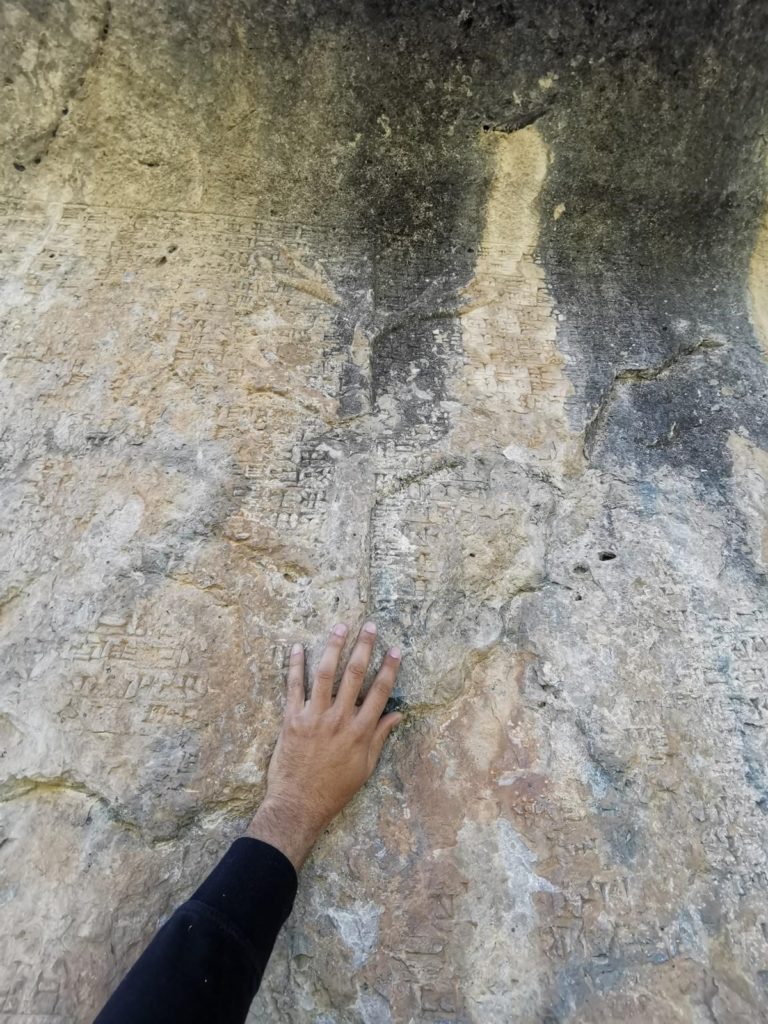Brisa village features two unique Neo-Babylonian inscription reliefs carved on the slopes of Wadi El-Sharbin.
Neo-Babylonian Empire
The Neo-Babylonian Empire (626 BC–539 BC) was the last of the Mesopotamian empires to be ruled by monarchs native to the area, before it fell to the first Persian empire. The kings of the empire were known to have undertaken massive building projects, consequently leading military campaigns to neighboring countries, notably Lebanon, to acquire wood as an essential construction resource.
At the time of king Nabuchednesszar II (605BC–562 BC), the cedar forests of northern Lebanon were widely exploited and used in the palaces and temples of Babylon.
This activity is attested in the inscriptions carved on two rock faces in Brisa village.
Location
The steles are located on a mountain road known as Wadi El-Sharbin, that connects the Bekaa to Mount-Lebanon from the west and the Syrian plain from the north. Thus, the importance of Wadi El-Sharbin for Nebuchadnezzar is based on the possibility to reach the forests of cedars and other resistant timber necessary to carry out his building projects, and as a quick passage from and to Babylon through Syria.
Reliefs
The western relief features an inscription written in old-Babylonian characters and features Nebuchadnezzar fighting a lion. This representation probably spells out the king’s strength.
The eastern relief is written in Neo-Babylonian cuneiform (logo-syllabic script) and it depicts Nebuchadnezzar standing in front of a tree without leaves. This representation probably spells out the king’s interest for the Lebanese timber and its precious value for his building projects.
Both reliefs are eroded due to natural and man-made factors.
Inscriptions
The inscriptions are written in forms of columns from top to bottom (a scetch of these columns can be found in the pictures at the end of the article). For the most part of the inscriptions, it speaks about Nebuchadnezzar’s military campaigns, religious processions, and public works in Babylon.
Mentioning Lebanon in the inscriptions reflect the intentions of Nebuchadnezzar’s conquest – the exploitation of the natural resources and the building of roads to gain ready access to them.
The king also mixes his political aims with a “concern for the welfare” of the locals.
Here is the part where Lebanon is mostly mentioned in the reliefs:
“On that day, Lebanon, the mountain of cedars, the luxuriant forest of Marduk (the patron god of Babylon) of sweet smell, whose excellent cedars whichnot …. for the cultic place of another god had not been taken for the (palace) of another king. I cut (with my pure hands) and – Marduk the king had called me (to bring this into effect) – (cedars) which were lift for a palace of a ruler, a king … heaven and earth, (Lebanon) where a foreign enemy had exercised rulership, and whose yield (the enemy) had taken away by force, so its people had fled, had taken refuge far away.
With the strength of my lords Nabu (patron god of scribes) and Marduk, I sent (my armies) regularly to Lebanon for battle.
I expelled its (Lebanon’s) enemy above and below and I made the country happy. I reunited the scattered people and I brought them back to their place.
What no former king had done (I did): I cut through the high mountains, I crushed the stones of the mountains, I opened up passes (into the mountains), I prepared a passage for (the transport of) the cedars for king Marduk.
Strong cedars, thick and tall, of splendid beauty, supreme their fitting appearance, huge yield of the Lebanon, I bundled them like reed sand I perfumed the (river) Arahtu (with them), and I put them in Babylon like Euphrates poplars. I let the people in the Lebanon lie in safe pastures; I did not allow an intimidator (against them).
So that nobody will oppress them, I installed an eternal image of myself as king to protect (them)…I built…I…I put ….
I reunited the scattered people, in the totality of all lands, and I wrote my inscription (and placed it) together with my royal image in the mountain passes, and I set it up for the future. May a future one read it, may he always mindful to speak the god’s praise”.
Similar texts in Nahr El-Kalb date back to the same king and era, though the relief is not accessible anymore since it is buried underground.
Karim Sokhn
Tour Operator & Tour Guide
References:
BAAL, Volume 12, 2008
https://www.britannica.com/art/Mesopotamian-art/Sculpture









